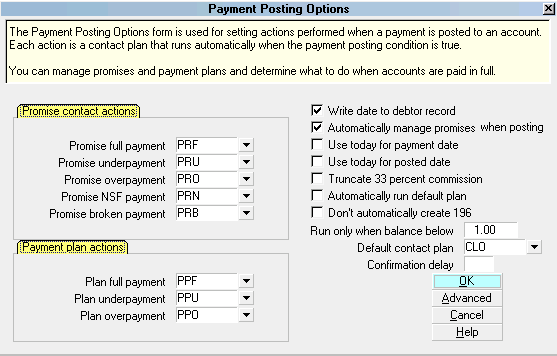Payment Plan Actions
Payment Plan Actions are contact plans used to
automatically manage payment plan payments. The actions
cover full payment, underpayment, and overpayment.
When a payment is received for an account that has a
payment plan, the amount and date of the payment are
evaluated to determine which action to perform on the
account.
Payment Plan Actions are set in the Payment Posting Options
form and are enabled when you switch ON 'Automatically
manage promises' in the same form.

Payment Plan Actions set in Payment Posting Options
 The contact plans used for payment plans must be
set up beforehand or must exist already in your system.
They are shipped with Collect! and may be copied from
the Demonstration database.
The contact plans used for payment plans must be
set up beforehand or must exist already in your system.
They are shipped with Collect! and may be copied from
the Demonstration database.
Collect! ships with plans and settings in place to manage
payments automatically. We will explain how each plan
performs.
We will cover:
- Automatically Manage Promises
- Promise Full Payment
- Promise Underpayment
- Promise Overpayment
Automatically Manage Promises
This switch in the Payment Posting Options MUST be
enabled with a check mark to manage your promises,
whether or not you choose to use Promise Contact
Actions. By itself, when switched ON, the switch will
handle promised payment on accounts, as outlined below.
- Collect! will advance the date in the Promise field
to the promised date of the next transaction
when a full payment is posted to the account.
- Collect! will not advance the date in the Promise
field when an underpayment is posted to the account.
- If the Due Date passes without a payment,
the Promise field will display as delinquent - red.
If there are contact plan codes in the Payment Plan Actions
section, then additional steps will be taken whenever an
account has a Payment Plan. Each of these steps is
described below.

Payment Plan Full Payment
The Payment Plan Full Payment (PPF) plan will run when
a payment is posted that matches the Amount of the
promised transaction for the account.
This plan writes a line to the debtor's Notes. You may add
your own events, such as sending a letter confirming
receipt of payment.
 Even without a plan in this section, Collect! will
display the next promised Due Date when a full payment
is posted to the account.
Even without a plan in this section, Collect! will
display the next promised Due Date when a full payment
is posted to the account.

Payment Plan Underpayment
The Payment Plan Underpayment (PPU) plan will run when
a payment is posted that is LESS than the Amount
set in the promised transaction for the account.
This plan writes a line to the debtor's Notes. You may add
your own events, such as sending a letter informing the debtor
that the promise was not met.
 Even without a plan in this section, Collect! will
not advance the date in the Promise field when an underpayment is
posted to the account, but will keep track of how much more
is needed to satisfy the promised payment.
Even without a plan in this section, Collect! will
not advance the date in the Promise field when an underpayment is
posted to the account, but will keep track of how much more
is needed to satisfy the promised payment.

Payment Plan Overpayment
The Payment Plan Overpayment (PPO) plan will run when
a payment is posted that is MORE than the Amount
set in the promised transaction for the account.
This plan writes a line to the debtor's Notes. You may add
your own events, such as sending a letter confirming
receipt of payment and informing the debtor that the
payment was an overpayment.
 Even without a plan in this section, Collect! will
advance the date in the Promise field to the Due Date of
the next promised transaction when an overpayment
is posted to the account.
Even without a plan in this section, Collect! will
advance the date in the Promise field to the Due Date of
the next promised transaction when an overpayment
is posted to the account.

Summary
Payment Plan Actions are contact plans that enable
you to perform custom actions as Collect! automatically
manages promised payments on your accounts. You can
schedule whatever events you need for full payment,
underpayment, or overpayment. Any payment posted to
an account with a Payment Plan will trigger one of the
payment plan contact plans.
Remember that whenever you use contact plans, you have
to be careful that you know every step the plans will take
on your accounts.

See Also
- Payment Plan Topics

| 
Was this page helpful? Do you have any comments on this document? Can we make it better? If so how may we improve this page.
Please click this link to send us your comments: helpinfo@collect.org